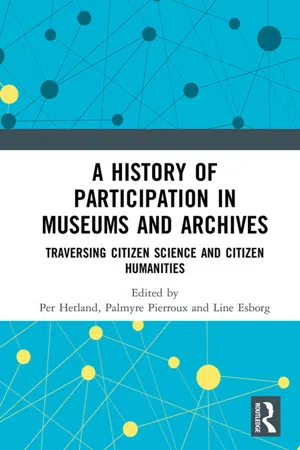Introduction
As our planet continues to experience rapid change in climate, biodiversity, and ecosystem functioning, it is clear that our very future depends on bridging the gap between science and society. In this chapter, we explore how one type of civic institution – museums of science and natural history – can help to catalyze and shape broader public learning and engagement around the socio-scientific problem of climate change. Science and natural history museums are valued as shared cultural assets, providing homes for scientists and science educators, housing scientific collections and interactive learning exhibits, and running educational programs for a wide range of audiences, from school children, to families, to adults. They are trusted and supported by the public and, in turn, often depend on the public (through entrance fees or government funding) for their very existence. It may not be surprising, then, that rather than leading the charge on difficult issues, museums may be tempted to choose a less-risky path. In terms of an educational identity, museums have traditionally preferred the role of a neutral party, focusing on helping people learn about settled scientific knowledge rather than being seen as advocates for social change or undecided aspects of controversial, urgent topics (Chittenden, 2011). When museums do choose to address difficult and urgent topics such as climate change, they often do so in ways that will not overtly challenge visitors or, worse, depress them (Knutson, 2019). After all, if visitors do not enjoy their museum learning experiences, they might not return.
However, museums of science and nature are increasingly looking for ways to break out of this complacent stance. There is growing understanding that museums have a responsibility to engage the public, not just in learning about pressing socio-scientific issues, but also in doing something about them (Watson & Werb, 2013; Steiner & Crowley, 2013; Davis 2016). Indeed, in recent decades, museums of all types have begun to move beyond acting as trusted purveyors of established knowledge, adding new kinds of civic engagement platforms to their programming. Supported by models of public engagement, public understanding, and public participation in research (Bonney et al., 2009), some museums have taken on a role to support public knowledge of science, as it emerges, when there are still debates about the direction, need, and intent of the science (Chittenden, 2011).
Climate change is a wicked problem in that it is unstructured, crosscutting, and relentless (Weber & Khademian, 2008). Social science has shown that public response to climate change is heavily influenced by social norms rather than rational thinking about scientific evidence (Kahneman, 2011; Kahan et al., 2012). Rather than seeing the educational process as the explanation of a technical problem that is well-defined with known solutions, climate change education, with its social and scientific complexity, becomes an adaptive problem as well (Kania and Kramer, 2011). When an answer is not known, or when no single entity could bring about a necessary change, then broader civic/science engagement that crosses geographical, temporal, and social distance is needed (Brugger, Morton, & Dessai, 2015).
In this chapter, we examine how museums partnered with a broad range of organizations to help cities learn about climate change as a wicked, adaptive problem and to respond to local impacts. The focal project, Climate & Urban Systems Partnership (CUSP), involved four cities in the northeastern United States. In each city, a museum served as the hub of a network of organizations that, either directly or indirectly, were connected to climate impacts in the city. To achieve the broader civic/science engagement needed to address climate impacts, the museums planned to work with their networks to develop community-based education interventions that were relevant and accessible to a wide range of people living in each city (Snyder et al., 2014; Knutson, 2019; Knutson & Crowley, Chapter 7, this volume).
Bridging science and community: a design-based research approach
Three key “bets” underlie the design of CUSP, the first of which we ended up referring to in the project as the “CUSP DNA,” a theory of action that emphasized the importance of local relevance, participation, and interconnectedness. By relevance, we mean that the topic must be presented in a way that meshes with a person’s or community’s interests and experience. Participation refers to the concept that connecting to a role, a concrete opportunity for engagement, or a possible next step with others creates a social identity with the topic. Interconnectedness is the idea that understanding how components of the issue impact each other can support systemic rather than solely individual change.
We recognized from the start that the standard museum approach of teaching people the science of climate change would not accomplish our goals. As argued in Allen and Crowley (2017), prior approaches to climate change education, grounded in a knowledge-first approach to behavior change, were driven by the assumption that if people are taught how climate change occurs, then they will change their behavior to reduce the impact. In this context, the low-hanging fruit of ready-to-disseminate educational experiences would focus on bits of scientific knowledge such as how the greenhouse effect works, the factors that cause sea-level rise, or the ways that individuals can reduce their carbon footprint by driving less or changing from incandescent to LED bulbs. However, in their review of the literature, Allen and Crowley found there is little evidence that such learning is likely to lead to adaptive behavior change.
Knowledge alone is certainly not sufficient (and perhaps not even necessary) in generating behavior change in ways that will enable effective systemic responses to climate change. Research argues instead for human-scale stories (Kahneman, 2011) and education that addresses values, ideology and place attachment (Marshal, 2014), with attention to personal experience with impacts and solutions, or interconnectedness (Marx et al., 2007; Sterman, 2011; CRED and EcoAmerica, 2014; Corner, Lewandowsky, Phillips, & Roberts, 2015).
The second bet underlying our work was the idea that broad civic/science engagement was best supported by heterogeneous networks, including community-based organizati...
